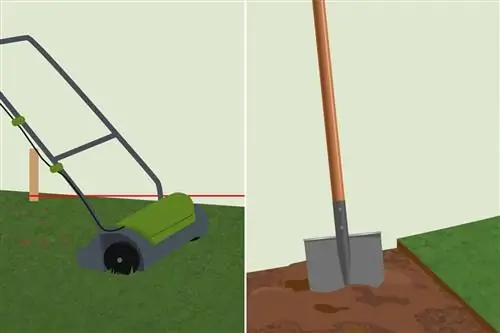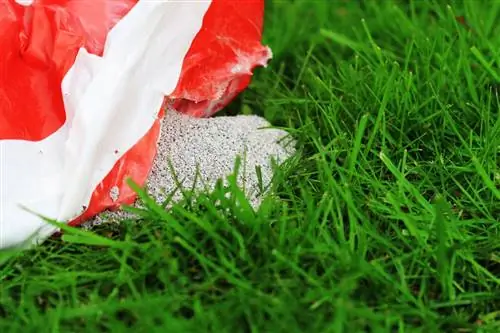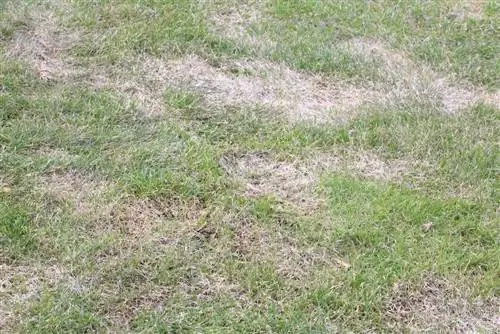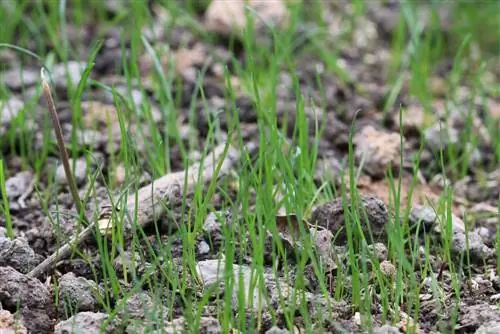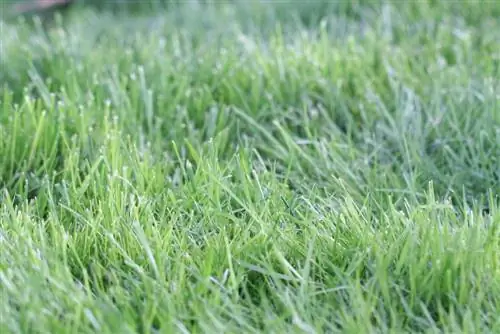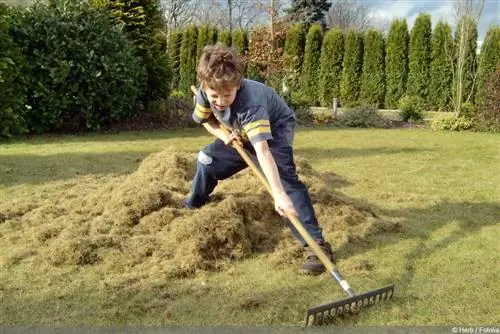- Author admin [email protected].
- Public 2023-12-17 03:39.
- Last modified 2025-01-24 12:45.
Unevenness in the lawn is annoying and poses a danger to gardeners, children playing and pets. There are various methods that can be used to level out the lawn. We present these to you in our guide.
Determine height difference: instructions
Before you can level out unevenness in the lawn, you need to know the actual height difference. This can be determined within a few minutes with little effort.
For this you need:
- 2 x wooden sticks
- 1 x cord
- 1 x spirit level
- 1 x ruler
Ideally, you should use a roll of string, for example parcel string, so that you have enough leeway when measuring. This is especially important for large lawns. The sticks should not be too short.
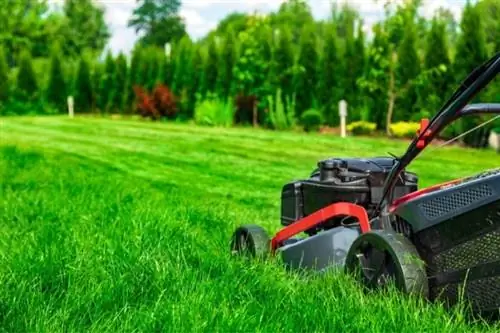
The height difference is then determined as follows:
- Find the highest and lowest points in the lawn. A sense of proportion is completely sufficient for this. Place a wooden stick at each selected location. They serve as points to fix the cord.
- Stretch a string between the pieces of wood. It must not sag, otherwise measurement errors may occur. The basis for determining the height difference is established.
- Now push the string at the highest point to the bottom end of the stick. Then push the end of the cord upwards at the lowest point until the cord is horizontal.
- If the line appears straight, use your spirit level for optimal alignment. Place the spirit level and adjust the string until it is exactly horizontal. This will prevent measurement errors that could have a negative impact on the project.
- Once the cord is completely aligned, you can measure the height difference to the floor using the ruler with the ruler. If you want to completely fill in the bumps, you can simply leave the cord standing and align yourself with the height. This is particularly recommended for lawns with several hollows so that you don't have to determine them individually.

Time
In addition to determining the height difference, it is important to pay attention to the appropriate time for the procedure when leveling the lawn. If the lawn is adjusted too late or too early in the year, damage can occur that has a negative impact on the vitality of the lawn. Since the lawn is a living area due to the grasses, you should not implement the project randomly. The period from mid-April to the end of May is particularly suitable for straightening the lawn. This is especially true for methods such as filling in bumps or removing individual hills, as you have to move a lot of earth. Since from April onwards there is usually only a small amount of meltwater left after the winter, the amount of work is significantly reduced. Ideally, choose a day with the following climate:
- no precipitation
- at least 10°C
- no risk of ground frost
Note:
Small pieces of lawn can also be repaired by September, as long as the procedure does not permanently damage the area.
Compensating uneven lawns: 5 methods
Refill
Filling is one of the most popular methods for leveling out unevenness in the lawn. With this method, low hollows are filled with a topsoil and sand mixture. The biggest advantage: You don't need to re-seed, as the grass seeds easily break through the thin layer when they germinate. Although you have to repeat the procedure throughout the season as the ground sinks slightly, you will end up with a naturally flat lawn.
You need:
- Mixing bucket or wheelbarrow
- Earth (topsoil)
- washed quartz sand (grain size 0 to 2 mm)
- Shovel
The implementation is very simple:
- Mix sand and topsoil
- Mixing ratio 1:1
- Fill troughs with mixture
- maximum layer thickness 1 cm
- water thoroughly
- let it rest for a period of 4 to 6 weeks
- repeat until fall
Reels
Rolling is ideal for small bumps where it is not worth using sand or earth to fill them. For example, if the entire lawn is only slightly uneven, rolling is ideal. For this method you need a lawn roller that has a working weight of 80 to 100 kg. Depending on the model, these are filled with the following materials:
- Sand
- Water
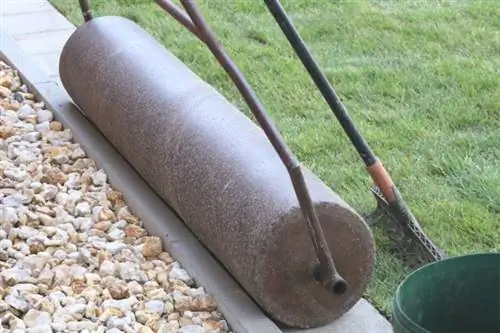
If you don't want to buy a lawn roller yourself because it costs between 50 and 300 euros per piece, you can rent it from hardware stores or specialist retailers. You have to expect a fee of 10 to 20 euros per day. If the lawn roller is ready, proceed as follows:
- Mowing the lawn before rolling
- water thoroughly when dry
- Fill roller
- Push or pull the roller over the lawn
- Train by train
- the tracks should overlap
- avoid tight curves (protects against displacement)
- optimizes the result
- Lawn can be walked on again after 24 to 30 hours
Note:
An alternative to the lawn roller is the vibrating plate, which is simply guided over the appropriate areas. You can rent vibrating plates in hardware stores, specialist retailers and online.
Removing the lawn
If filling or rolling the area is not enough to compensate for the unevenness, you will have to remove the lawn, willy-nilly. This is particularly the case with lawns that are very hilly, which would lead to an extremely high amount of work using the methods already mentioned. For this reason, you need to remove the lawn to level it as effectively as possible.
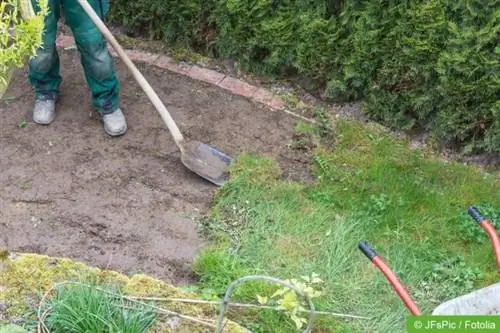
For the project you will need the following utensils and materials:
- Lawnmower
- Scarifier
- Lawn roller
- Shovel
- Wheelbarrow
- Earth (topsoil)
- washed quartz sand (grain size 0 to 2 mm)
- Work gloves
- other tools for weed removal such as weed cutters
- Calculations
- Lawn fertilizer
- Lawn seeds of your choice
Removing the lawn is similar to a complete renovation:
- Start by mowing the lawn thoroughly and as short as possible. You do not have to dispose of the grass clippings as they are used as natural fertilizer. Additionally remove weeds so that they can no longer spread after the new plant has been planted.
- Now you have to scarify the entire area. If the soil is too dry for this, simply water it a little. When scarifying, remove small hills and larger bumps to bring the height into line with the rest of the soil.
- After scarifying, fill the dug up area with a sand-topsoil mixture in a 1:1 ratio if the desired height has not been reached after removal. Use the previously measured difference in height or the guideline that you have not yet removed as a guide. You can use the rake to level off the surface.
- Wait five to seven days. The soil will now have settled somewhat, making it easy to fill in any necessary areas with additional soil. Repeat this step again if necessary.
- Finally, roll the area and supply lawn fertilizer and lawn seeds. Water thoroughly and care as usual.
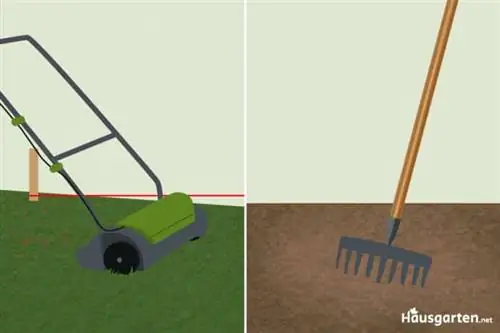
Repair parts
If there are small areas of the lawn that need to be leveled, you can save yourself a lot of work. This is possible by removing the turf in the respective area, adjusting the soil and then placing the lawn correctly again. The section will establish itself over the next few weeks and ensure a well-contained lawn area without the risk of tripping. In addition to the utensils mentioned so far, you need a lawn edger for this method. It allows you to make a clean and easy cut into the lawn to remove the sections without damaging them. The tool is available for 20 to 30 euros.
The following instructions will guide you through the individual steps of the method:
- Prick the desired area with the lawn edger. To do this, use a cross shape to divide the piece into four parts. Don't forget to pierce the edge of the piece too.
- Now fold the individual pieces inside out to remove them. This makes it possible to easily remove them and re-establish them later. Theoretically, you can simply leave it lying there after unfolding it and then fold it back down again at the end.
- Thoroughly loosen the soil under the lawn with the spade to loosen any possible compaction. This also makes it easier for the sections to grow, as the soil is much more air-permeable and structured.
- You can then fill or remove the area as necessary. To do this, follow the instructions described so far. Tamp the soil thoroughly so that the pieces can rest exactly.
- Then simply place the pieces back on the ground. If you still see any unevenness, repeat the process. The lawn can then be cared for as usual.
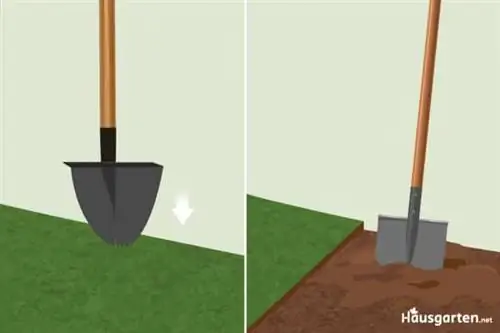
Note:
Use barrier tape to mark the repaired area in the lawn. This prevents the lawn from becoming uneven again due to too early loading.
Planting ground cover plants
Planting ground cover plants is another method to compensate for unevenness in the lawn. This is only recommended for small areas or if the uneven surface is on the edge or in the corners. Ground cover plants grow low and form dense cushions that are suitable for adapting to small differences in height. Depending on the type you choose, you will have to adapt the soil in the desired location to the plant's requirements and fill it with substrate. The ground cover then functions as a lawn replacement and even provides decorative accents.

Recommended ground cover for uneven lawns are:
- Plumage pads (Cotula squalida)
- Pennigwort (Lysimachia nummularia)
- Polei mint (Mentha pulegium)
- Roman chamomile (Chamaemelum nobile)
- Sand thyme (Thymus serpyllum)
- Hot Stonecrop (Sedum acre)
- Star moss (Sagina subulata)
Frequently asked questions
How is an uneven lawn created?
The most common cause is waterlogging, which is caused by compacted soil or missing or inadequate drainage. This is followed by depressions that lead to unevenness. Animals such as moles and voles can also visibly dig up the lawn. Other reasons include excessive strain on moist soil, tree and shrub roots, and errors in laying the lawn.
What should you pay attention to after the procedure?
The lawn should be watered thoroughly after the unevenness has been leveled out. This prevents the soil from drying out immediately, which in turn would lead to compaction. Depending on the method, new seeds must also be sown and fertilizer incorporated.

